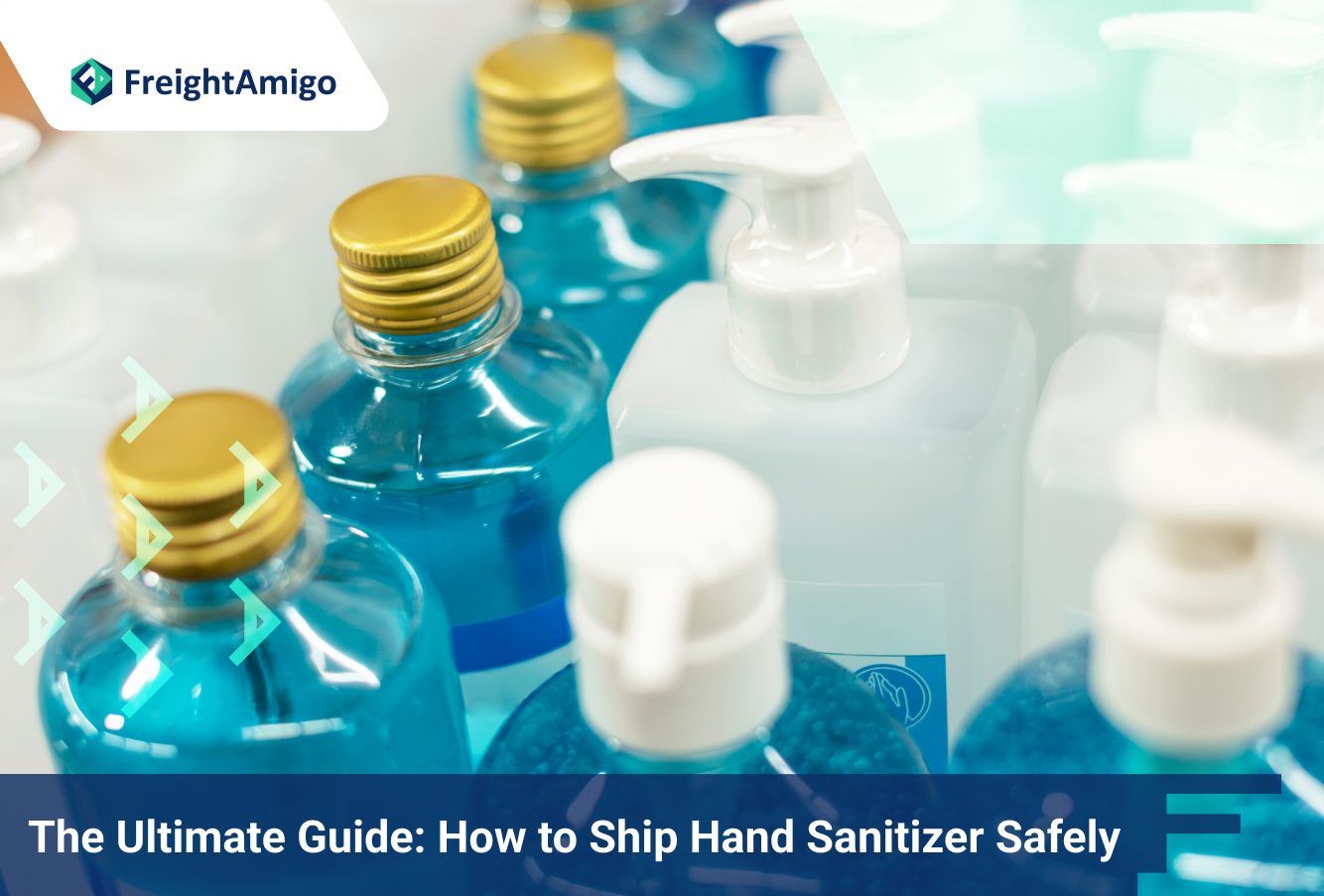Author Name: Tiffany Lee – Marketing Analyst at FreightAmigo
In today’s world, hand sanitiser has become an essential item for everyone. Whether it’s for personal or business use, the demand for hand sanitiser is higher than ever. But when it comes to shipping hand sanitiser, there are certain regulations and guidelines that need to be followed to ensure it is transported safely and efficiently. FreightAmigo provide this ultimate guide will take you through the process of shipping hand sanitiser, from understanding the regulations to choosing the right carrier.
Want To Compare The Best Express, Air Freight, Sea Freight, Rail Freight & Trucking Rates So As To Have Better Control On Cost?
Why it is important to ship hand sanitiser safely
Safe shipping of hand sanitiser is important for a number of reasons. First and foremost, it ensures the safety of the people handling the parcels. Hand sanitiser contains alcohol, which is highly flammable. If not properly packaged and shipped, it can pose a significant risk in transit. Secondly, following the rules for shipping hand sanitiser will help to avoid legal problems. Different countries and regions have specific rules and guidelines when it comes to shipping hazardous materials, and hand sanitiser falls into this category. By following these regulations, you can avoid potential fines and penalties.
Understanding the regulations for shipping hand sanitiser
Before shipping hand sanitiser, it’s important to familiarise yourself with the regulations and requirements of the relevant authorities. The International Air Transport Association (IATA) and the International Maritime Organisation (IMO) have specific guidelines for the transport of dangerous goods, including hand sanitiser. These guidelines cover various aspects such as packaging, labelling, documentation and quantity limits. It’s important to review these guidelines thoroughly and ensure compliance to ensure the safe transport of hand sanitiser.
In addition to IATA and IMO regulations, it’s also important to check the local regulations of the destination country or region. Some countries may have additional requirements or restrictions when it comes to shipping hand sanitiser. Understanding and complying with these regulations will ensure a smooth and hassle-free shipping process.
Packaging requirements for shipping hand sanitiser
Proper packaging is key to the safe transportation of hand sanitiser. Packaging should be designed to prevent leakage and breakage during transport. Here are some key packaging requirements to consider:
Use strong and leak-proof containers: The hand sanitiser should be stored in containers specifically designed for hazardous materials. These containers should be able to withstand the rigours of transport and be leak-proof to prevent spillage or leakage.
Secure containers: Containers should be securely closed and sealed to prevent accidental opening during transport. It’s recommended that tamper-evident seals are used to ensure the integrity of the package.
Cushioning and padding: Appropriate cushioning and padding should be used to protect containers from shock and vibration during transit. This will help prevent breakage or damage to the hand sanitiser bottles.
Outer packaging: Containers should be placed in strong outer packaging that meets the carrier’s requirements. This outer packaging should be properly labelled and marked to indicate the presence of hazardous materials.
By following these packaging requirements, you can ensure that your hand sanitiser shipments are well protected and ready for transport.
Tips for Labelling and Documenting Hand Sanitiser Shipments
Correctly labelling and documenting hand sanitiser shipments is essential to ensure compliance and to provide the necessary information to the carrier. Here are some tips to help you label and document hand sanitiser shipments:
Hazardous material labels: Hand sanitiser is considered a hazardous material due to its alcohol content. It’s important that packages are marked with the appropriate hazardous material labels. These labels should be clearly visible and comply with the carrier’s regulations.
Proper documentation: Complete and accurate documentation is critical when shipping hand sanitiser. This includes the Material Safety Data Sheet (MSDS), which provides detailed information about the product, its ingredients and any potential hazards. The MSDS should be included in the shipment and made available to the carrier upon request.
Shipping papers: Depending on the quantity and mode of transport, you may be required to provide shipping documentation, such as a Dangerous Goods Declaration or Bill of Lading. These documents provide information about the shipment, including the type of hazardous material, quantity and packaging.
By ensuring proper labelling and documentation, you can help the carrier handle your hand sanitiser shipments safely and efficiently.
Common mistakes to avoid when shipping hand sanitiser
When shipping hand sanitiser, it’s important to avoid common mistakes that could result in delays, fines or even rejection of your shipment. Here are some common mistakes to avoid:
Improper packaging: Using inadequate or inappropriate packaging can result in leaks, breakage and damage to hand sanitiser bottles. Be sure to use packaging that is specifically designed for hazardous materials and meets the carrier’s requirements.
Incomplete or inaccurate documentation: Failure to provide complete and accurate documentation can lead to delays and non-compliance. Check all required documents and ensure they are properly completed and signed.
Failure to comply with labelling requirements: Incorrect labelling or failure to mark packages with the appropriate dangerous goods labels can result in rejection or delays. Be sure to follow the carrier’s labelling requirements and ensure that the labels are clearly visible.
By avoiding these common mistakes, you can ensure a smooth and problem-free shipping process for your hand sanitiser shipments.
Choosing the right carrier for hand sanitiser
Choosing the right carrier is critical when shipping hand sanitiser. Not all carriers accept hazardous materials, and even those that do may have specific requirements and restrictions. Here are some factors to consider when choosing a hand sanitiser carrier:
Experience and expertise: Look for a carrier that is experienced in handling hazardous materials, including hand sanitiser. They should be familiar with the regulations and have the expertise to ensure safe transport.
Compliance: Ensure that the carrier follows all relevant regulations and guidelines for shipping hand sanitiser. This includes proper handling, packaging, labelling and documentation.
Insurance coverage: Verify that the carrier provides insurance coverage for hazardous materials shipments, including hand sanitiser. This will provide additional protection in the event of an accident or damage in transit.
Tracking and monitoring: Look for a carrier that offers tracking and tracing services for your hand sanitiser shipments. This will allow you to keep track of the packages and ensure timely delivery.
By carefully considering these factors, you can choose a reliable and trustworthy carrier for your hand sanitiser shipments.
Conclusion: Ensuring the safe and efficient shipment of hand sanitiser
Safe hand sanitiser shipping requires careful attention to regulations, packaging requirements, labelling, documentation and choosing the right carrier. By following the guidelines and tips in this ultimate guide, you can ensure that your hand sanitiser shipments are transported safely and efficiently. Remember to check regulations, use proper packaging, label and document shipments correctly, and avoid common mistakes. Most importantly, choose a carrier with experience and expertise in handling hazardous materials. By taking these steps, you can rest assured that your hand sanitiser will reach its destination safely. For more information and assistance with shipping hand sanitiser, contact FreightAmigo to arrange a demonstration.
There Are Different Options For Cargo Transportation. If You Want To Choose The Most Convenient And Suitable Solution, It Is Best To Have The Full Support Of Logistics Experts! If You Are Planning To Ship Goods Overseas, Please Go To The FreightAmigo Page For Inquiries.
===
Read More:
【Cosmetic Product Recycling】 A Guide to Sustainable Reverse Logistics
【Rise of Green Supply Chain】 Pioneering Sustainable Practices in Logistics
【ESG in Logistics】 How ESG Practices Drive Social Responsibility in Logistics
===
If you have any inquiries on logistics/supply chain, feel free to contact FreightAmigo now:
Chat with us online OR
Phone : +852 28121686
WhatsApp: +852 27467829



